The dream of every person is to have a large and comfortable house where you can relax with your soul and body. In order to create such a mood in the room, you need to carry out repairs in accordance with your desires. Designers help design custom interiors, but labor and material costs can be too high.
Then the well-known material comes to the rescue - polystyrene foam or polystyrene foam. Universal in its properties, it is suitable for both insulation and surface decoration.
The article details such a popular EPS material as ceiling tiles. How to choose and what to look for when buying, what features and disadvantages it has, how to glue it correctly - you will learn all this from the material provided. Manufacturers will also be reviewed.
Features of Styrofoam
Expanded polystyrene, and in the people - polystyrene, is often used to finish the ceiling. Applications are varied, fromconstruction works to decorative finishing of premises. There are many reasons for this. The main one is the low cost of the material. Most often, polystyrene foam boards and blocks are used to insulate buildings. It can be cottages, and baths, and apartment buildings.
The main properties of expanded polystyrene are that it does not absorb moisture and does not burn. The material also occupies a leading position among noise-insulating coatings. Due to its dense and homogeneous structure, it does not let in noise and is able to retain heat.
Styrofoam allows you to decorate ceilings and even walls. The products are lightweight and easy to install. The material is easy to cut, which allows it to be used on ceilings of irregular shapes.
Varieties of ceiling tiles
Pressed tile. The thickness of such a coating ranges from 6 to 8 mm. By construction standards, the material is quite fragile and requires careful handling. The main advantage of such coverage is its cost. For production, the method of mechanical stamping is used. Slabs are made from ready-made polystyrene blocks by cutting into thin layers, which subsequently become tiles. Compared to other species, it has the shortest service life
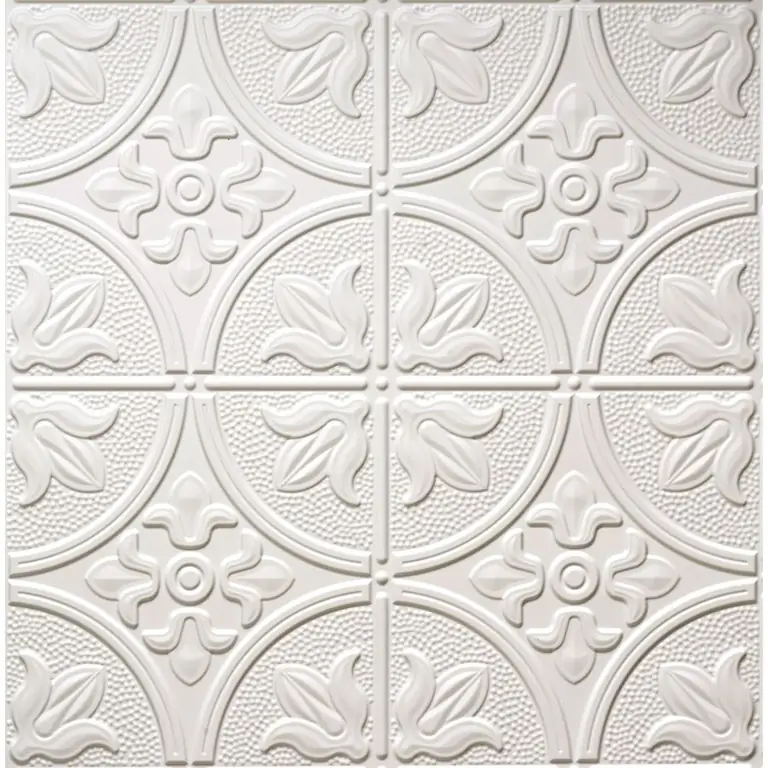
Injection tiles. The thickness is 9-14 mm. Produced by sintering a foam solution at a very high temperature in a special form. This tile has increased soundproofing properties. Able to keep warm. Refers to seamless materials. Most often this type isrelief drawing. If you need colored polystyrene foam ceiling tiles, then you should pay attention to this particular type. But, unfortunately, with all the advantages, the coating has a big drawback - it is unstable to damage and moisture. Its use in the kitchen and bathrooms is strictly prohibited
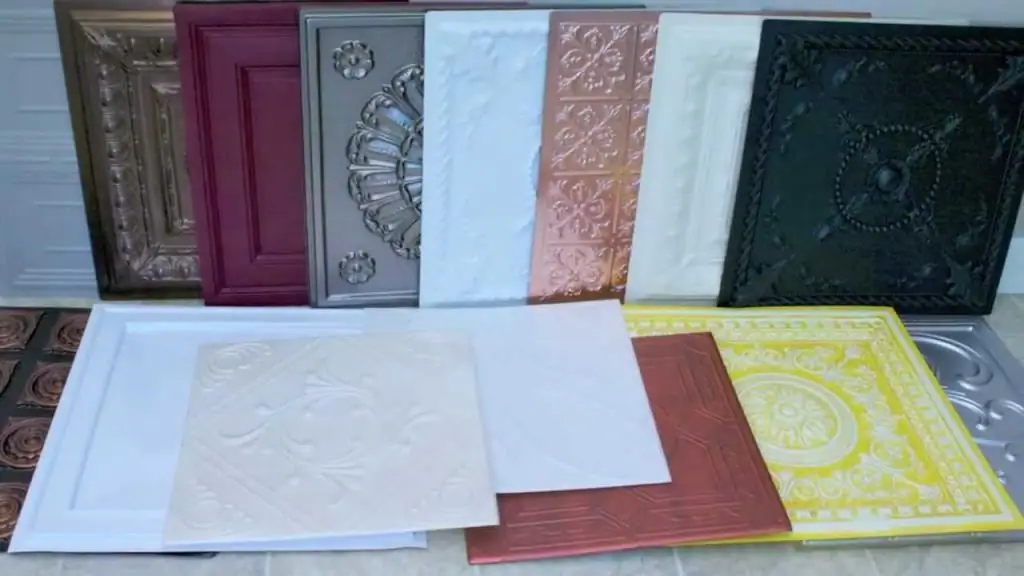
Extruded. This coating option is considered the most durable and durable. Manufacturers offer a wide range of colors and shades. For its manufacture, extruded polystyrene foam is used, which is produced under pressure at high temperature on a special machine and covered with a protective film. This makes the material much stronger. The product has a smooth glossy surface, which allows you to paint it during operation. This type of tile is the most expensive
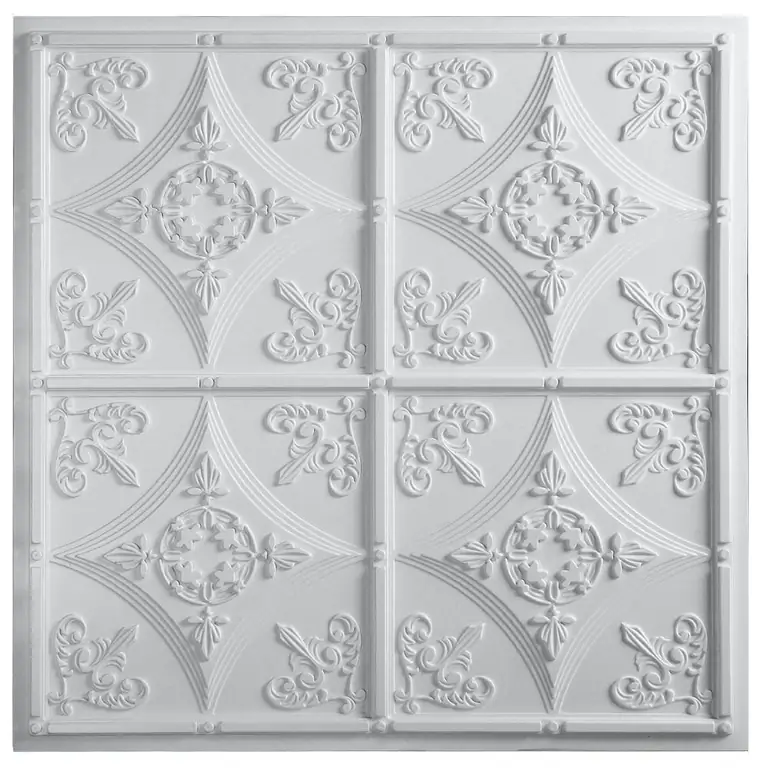
Dignity
Polystyrene ceiling tiles are quite a popular material for decorative ceilings. The list below highlights the benefits of styrofoam tiles:
- Low cost. Yes, compared to other finishing materials, tiles can be classified as an economy class. If the budget is modest, but you need to update the ceiling, this is the best option.
- The ability to keep warm. Expanded polystyrene tiles act not only as a decor. To insulate the ceiling with polystyrene foam from the inside, tiles are often used.
- Good sound insulation. Along with insulation, the material is also used asadditional soundproofing measures.
- Variety of textures. Yes, this is a really big plus. Smooth tiles give a nobility to the room, but embossed tiles add luxury.
- The wide range of shapes of EPS ceiling tile allows it to be used for finishing irregularly shaped surfaces.
- Wide range of colors. Standard white ceilings are a thing of the past. Modern ideas for decorating ceilings and the interior as a whole are very bold and extraordinary. A wide palette of colors allows you to decorate both the nursery in bright colors and the bedroom in gentle colors. Shades can be selected as desired.
- Safety and hypoallergenic. Although expanded polystyrene cannot be called a natural material, it is absolutely safe. The most important thing is to choose an honest and trusted manufacturer. When buying, ask the seller to provide a quality certificate and an SES conclusion. It is these documents that confirm that the material can be used without fear.
- Can be used to finish uneven surfaces. Small bumps and dents on the ceiling will not be a problem. The tile will help create a smooth ceiling due to its plasticity.
- Even a beginner can handle editing. It really is. In order to perform pasting the ceiling, you do not need special education. It is enough to see how it is done once.
- Not flammable. The material does not ignite when exposed to high temperatures, it only melts. Can be safely used in the kitchen.
- Practical. It can be used in absolutely any room. Exceptionsare only public places (bars, clubs, discos). This is only related to fire safety. There are no restrictions in living quarters.
Flaws
Like any other finishing material, Styrofoam tiles have some drawbacks:
- Short service life. Even if we take into account that the material is produced by chemical processes and is not subject to decay, fungus and mold, the service life is still low. You can find manufacturers that offer options that are more durable, of course for the appropriate price.
- Some materials are afraid of moisture. Yes, this is very inconvenient, because tiles are sometimes used even in the design of the bathroom. But the good news is that this does not apply to all materials.
- Easily melts when the lamp is close. This is not such a serious drawback. But you shouldn't ignore it. Just lower the chandelier 10 cm lower. The general appearance of the room will not suffer from this, but you will not have to worry about security.
Seamless tile
This kind of EPS ceiling tile is the most popular. Decorative tile, which gives the impression of a solid canvas, is taking the leading position among finishing materials. This is due to the fact that with the help of such a finishing material, you can easily and quickly update the interior, create a beautiful embossed surface without large financial costs.
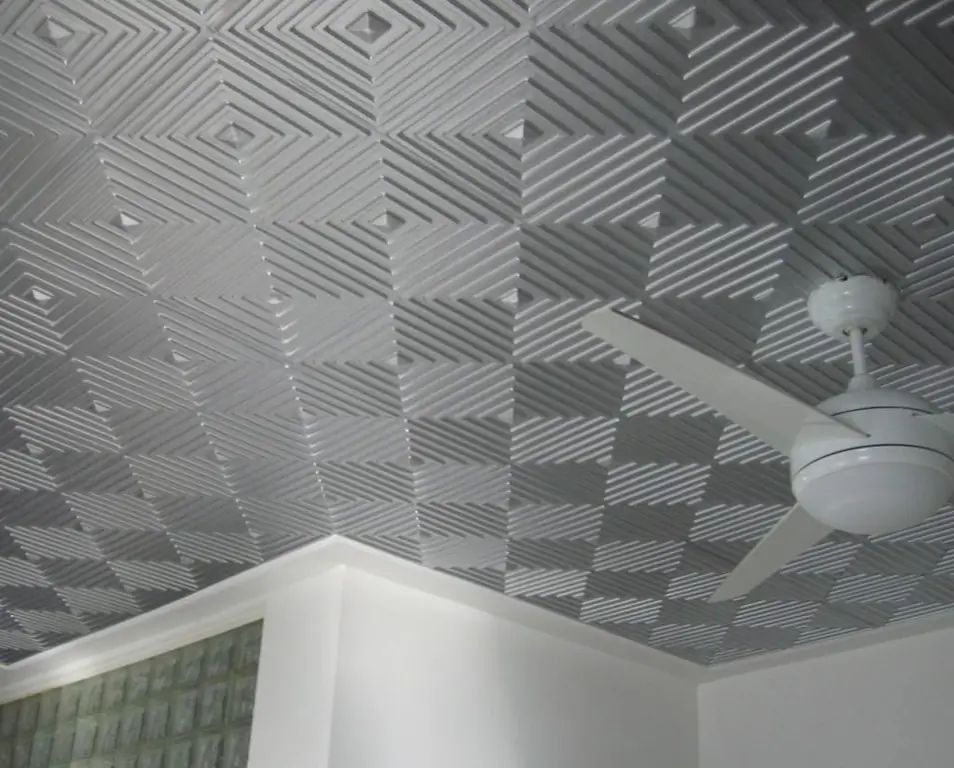
Seamless Styrofoam ceiling tiles allow you to create compositions and emphasize individualelements in the interior. Designers, of course, are not enthusiastic about such material, speaking of it as cheap consumer goods. Actually, it is not. The availability of the material allows the consumer to create and change the design of the room himself.
How to choose the right one?
Of course, many are wondering how to choose the right polystyrene ceiling tiles. You should choose according to the following criteria:
- The sides are symmetrical, the corners are straight without roundness. A square tile that has even the slightest visual discrepancy should be sent to marriage. It is simply impossible to work with such material.
- The composition of polystyrene should be the same, the grains should be identical, fit snugly against each other, the edges should not crumble. The surface of a smooth and textured tile should be free of dents and scratches.
- The pattern or relief is even, symmetrical, without dents or hooks.
- It is very easy to check the strength of the tile, as well as how correctly the information on the package is indicated. It is necessary to take the product by one edge and keep it in the air. If a crack or some kind of creak is heard at this time, then most likely the material is not of high quality and will not last long. Styrofoam ceiling boards are capable of supporting their own weight.
- Decorative Styrofoam ceiling tiles should have a clear pattern, which, when connected, will be a continuation, and not a separate fragment.
How to calculate quantity?
Calculation is based on the area of the ceiling. To do this, it is enough to create a drawing on paper. Ceiling tile dimensionsfrom expanded polystyrene are now standard, 4 tiles go to 1 square meter. The calculation starts from the center of the room.
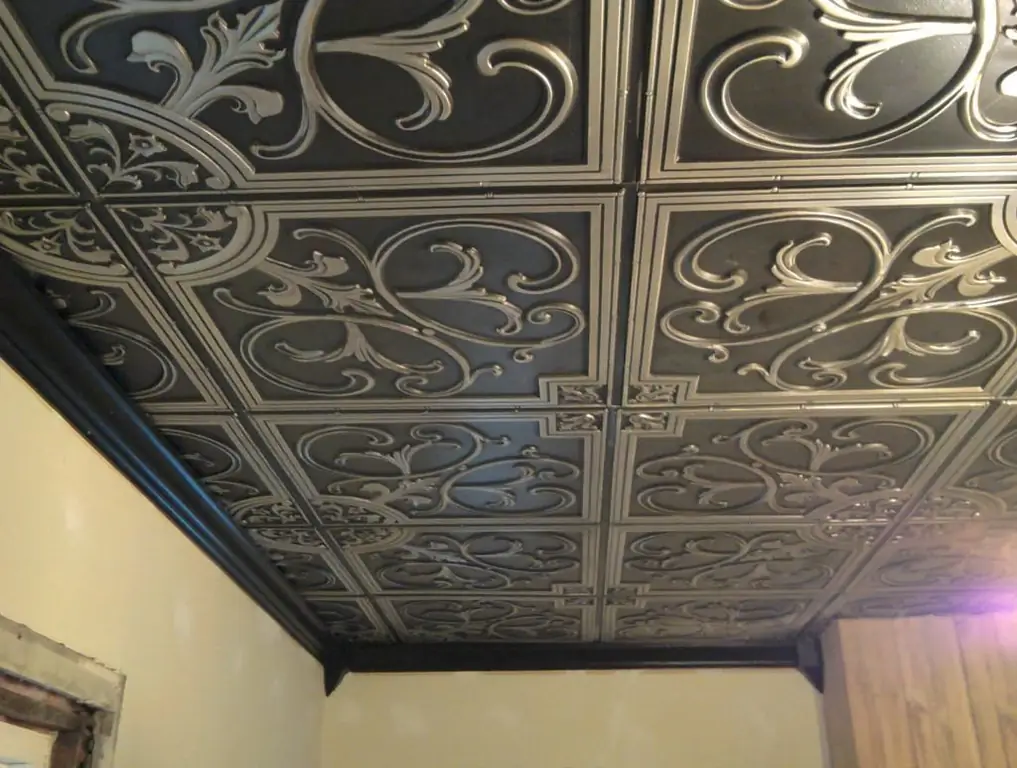
Experts recommend taking material with a margin. Anything can happen during repairs, so a stock of products must be required. In the case of tiles - approximately 20 - 30%.
Which glue to use?
In order for the material to hold tightly and please you with its appearance, it is worth using a specially developed adhesive for polystyrene foam ceiling tiles. People call it "liquid nails". If this was not on sale, you can use other rubber-based construction materials. They are quite popular and are always available in any hardware store. They have a dense viscous texture and provide a quick setting of the material to the surface.
The strongest grip will provide a rubber-based adhesive. But when working, it is worth keeping the time between application and gluing, it ranges from two to seven minutes. Read the instructions carefully before use.
Surface preparation
Most people during repairs are faced with such a problem as uneven ceilings. This phenomenon is quite common, especially for old houses. But there are no hopeless situations. The surface of the ceiling can always be leveled. And for this it is not necessary to have special knowledge.
Before gluing the ceiling tiles, the surface must be thoroughly cleaned. Otherwise, the appearance of the finished work will not be perfect. Where to start? In-First, you need to get rid of the dust. You can use a regular brush for this. Now it is worth wiping the surface with a damp cloth. Pay particular attention to the chalk-covered ceiling.
If your house does not have a perfectly flat ceiling or there are cracks in it, then a primer will come to the rescue. It can mask old holes, cracks. Now with the help of putty we make the surface homogeneous. Your ceiling is ready.
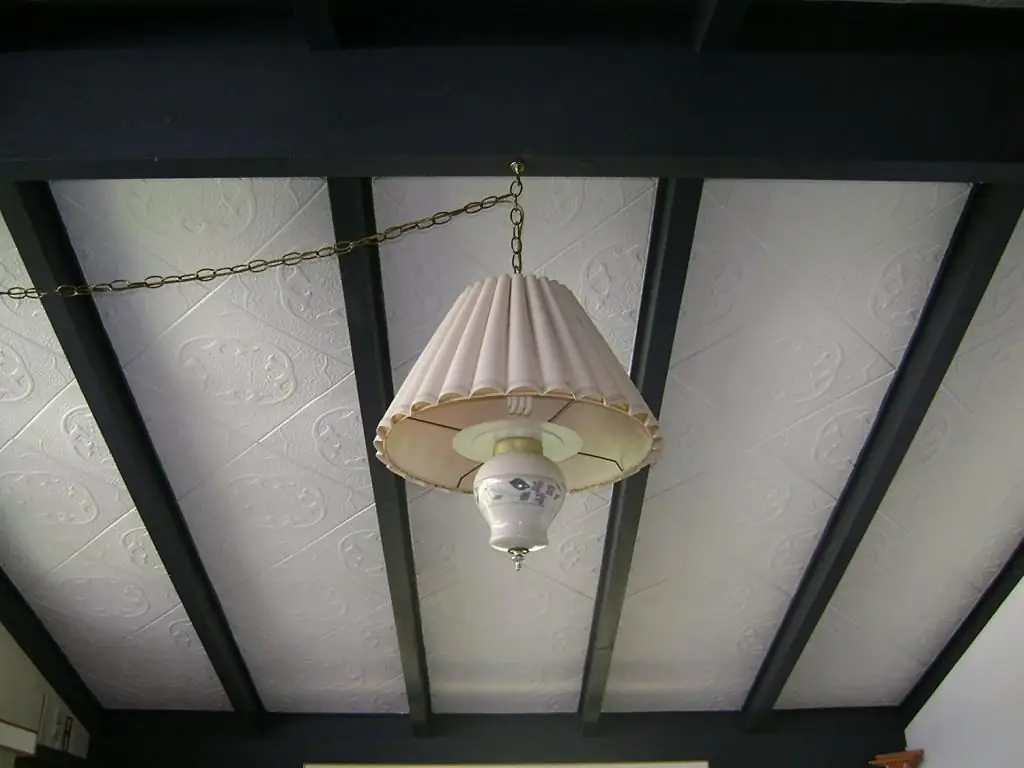
How to glue?
There are many ways to glue tiles on the ceiling, but the main one is gluing the ceiling from a chandelier:
- The most important thing is the correct calculation. The easiest way to do this is for square and rectangular ceilings, but with a non-standard shaped surface, you will have to suffer. After that, you need to calculate the segments, more precisely, their area. Standard sizes are 50 x 50 cm, but rectangular ones are also available.
- The next step is to prepare a rhombus under the chandelier. To do this, mark the ceiling diagonally.
- Now you should apply glue around the entire perimeter and in several places in the center. It is better to do this in a dotted way, at a distance of 2-3 cm. The tile must be pressed against the ceiling and held with force for several minutes.
- The rest of the material is glued in the same way.
- It is important to ensure that the joints of the tiles completely match and do not form gaps. There are times when, due to an uneven surface, this cannot be avoided. Do not worry, after the end of gluing, you will be able to evaluate all the shortcomings and correct them.
- You need to work very hardcarefully so as not to create dents on the surface. You need to be especially careful with embossed patterns, which are especially sensitive to any mechanical stress.
- If there are gaps in the corners or along the walls, use a polystyrene skirting board. It is glued in the same way as the tile.
- There are situations when it is impossible to make the joints perfect. A sealant will come to the rescue, which will carefully mask all the gaps.
Thanks to these simple tips, gluing tiles to the ceiling will be easy even for a novice builder.
Painting ceiling tiles
No matter how strange it may sound, ceiling tiles can be painted. Of course, not all types are suitable for this, but, for example, extruded is quite capable of coping with such a task. The most budget tile, which is produced in a pressed way, will not work. It is thin, the paint will be absorbed into the porous surface, the appearance will not only not get better, but may deteriorate altogether. Injection, although it has a sufficient thickness, but under the influence of paint, it can lose its beauty and texture. This is due to the fact that the material absorbs moisture, and the paint, although thick, is still liquid.
You can use any paint for coloring. It can be both water-based and enamel. Most often, this is done in order to refresh the appearance of the material. Or in order to change the style of the interior without cardinal expenses of finance and time.
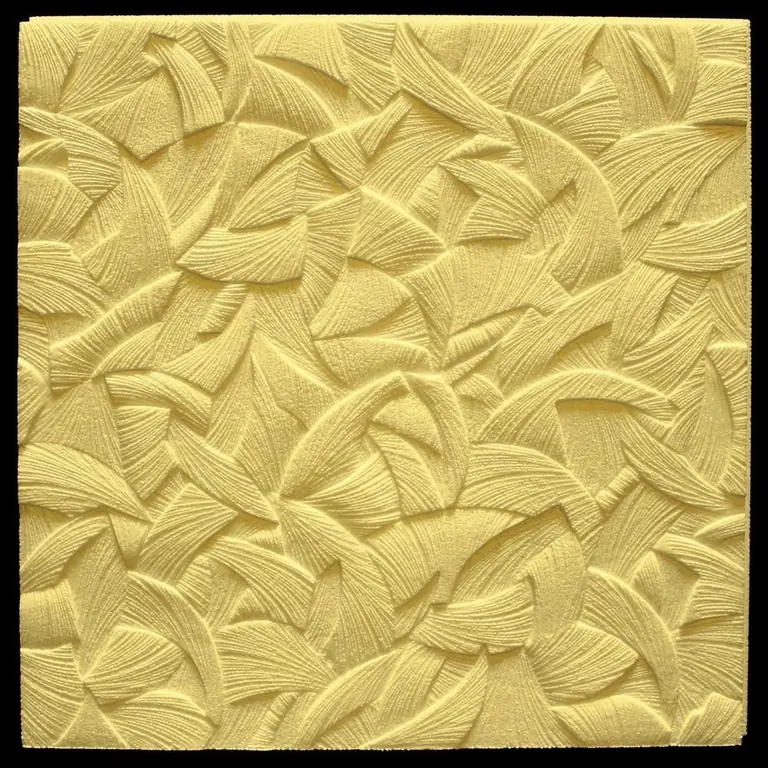
Still very often they paint tiles due to the fact that its main purpose- warming of the room. And after some time, the design decided to change. This is where paint comes to the rescue.
If the tile is smooth, then it will not be difficult to paint it. The work is done with a roller. Depending on the chosen paint, one or two layers are applied. In the case of relief material, you need to use a brush. How many layers to apply, see the result.
Producers
To find a product that will last a long time and will delight you with its appearance, you should refer to the information on manufacturers. In the building materials market, you can find both well-known foreign brands and Russian ones. Which company to choose is up to you. Below is a list of the most popular and sought after companies:
- "Armstrong". The company occupies a leading position among the manufacturers of expanded polystyrene ceiling tiles. The range is very varied. Available in a variety of colors and shades. The format of manufactured products is diverse - there are both budget options and individual non-standard ones. The price matches the quality.
- "Ormit". Manufacturer from Germany. The company has established itself as a responsible manufacturer of moisture resistant ceiling tiles. The range is very diverse both in colors and sizes.
- "Matrix". This is a manufacturer from China. It produces products that occupy the lowest price segment. The quality is consistent.
- "Format". This company is from Russia. On the market not so long ago, but already has its customers and releases all new color options andsizes. It is worth paying attention to the price category. Compared to foreign manufacturers, it offers quite budget options.
Whatever manufacturer you choose in the store where the goods are purchased, you have the right to demand documents for the products. The most important thing is the certificate of conformity to quality, as well as the conclusion of the sanitary and epidemiological examination.
Summing up
So we figured out how to glue and how to choose the right polystyrene foam tiles for the ceiling. It remains only to start the repair. Always remember that repairs are not only financial costs, but also temporary ones. And time is very valuable. Ceiling tiles will help you save both the family budget and the time that you can later spend with your family.






